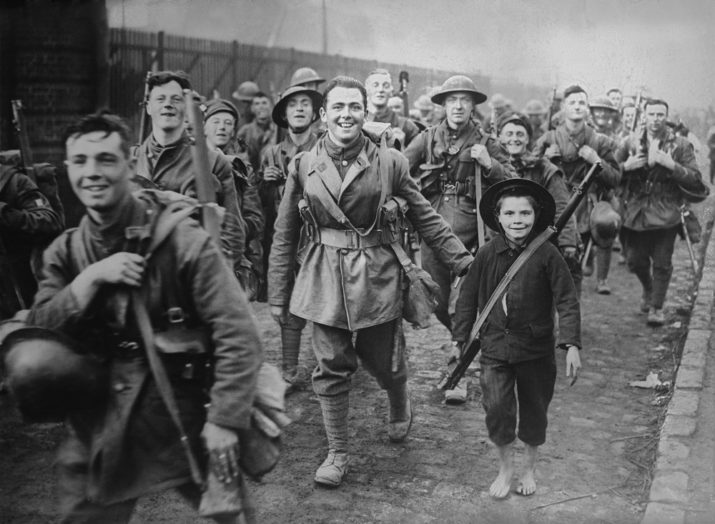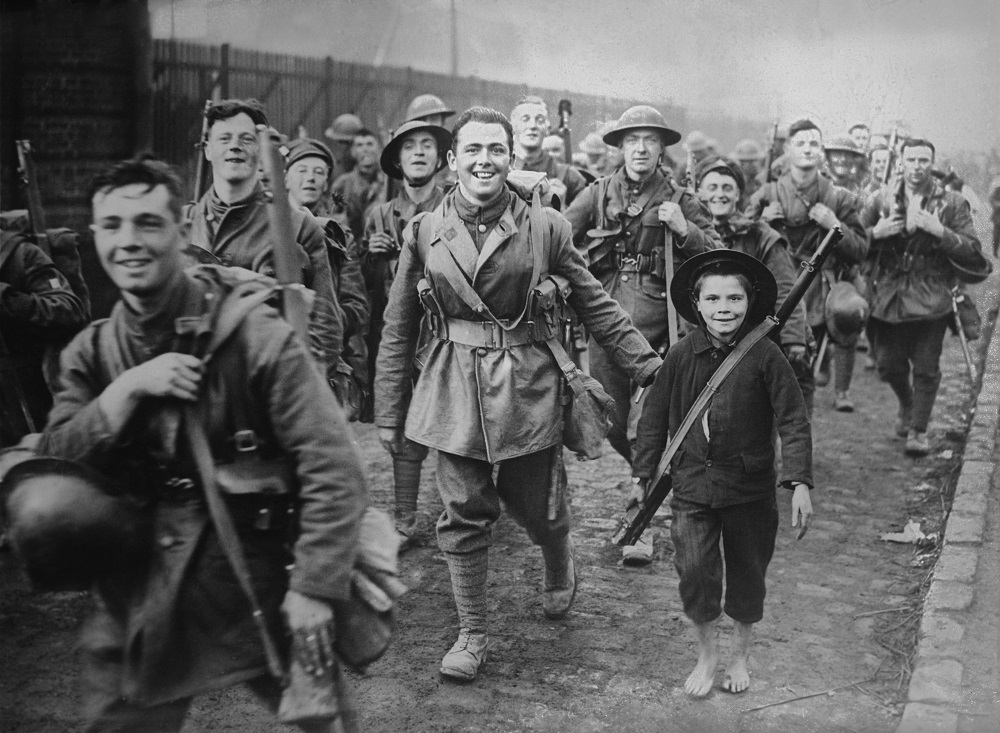

This is part of our special feature Memory and the Politics of the Past: New Research and Innovation.
World War I created a watershed in world history. The War led to Communism, fascism and Nazism, the Great Depression, World War II, as well as the Cold War, and began the decline of Western imperialism and the rise of the European social welfare state. It punctured belief in progress and radically shifted art, theology, psychology, and literature. Without the slaughter at Verdun, where armies suffered 700,000 casualties in ten months and neither side gained any ground, neither Auschwitz nor Hiroshima could have happened. As philosopher William Barrett wrote in his classic study, Irrational Man, “August 1914 is the axial date in modern Western history, and once past it we are confronted with the present-day world.”
The War profoundly shaped historical memory by changing the way we commemorate wars, as shown beautifully in Jay Winter’s Sites of Memory, Sites of Mourning. Aside from a few cemeteries from the Franco-Prussian and U.S. Civil Wars—Gettysburg is the prime example—statues of victorious generals on mounted steeds had been typical war monuments. Because World War I took place in an age of democracy and mass literacy, the common solider, rather than generals, became the focus of memory. Every country recognized the conflict through seas of crosses and mind-numbing lists of names on memorials. The Versailles Treaty’s Article 225 even provided that both sides would maintain “the graves of the soldiers and sailors buried in their respective territories.” Because artillery accounted for over 70 percent of fatalities, millions of dismembered bodies could only be memorialized through tombs to the Unknown Soldier, a creation of the Great War. Western and Eastern Europe, as in the War and so much of twentieth century history, diverged in their commemorations. In Britain, France, and Germany, remembering the War’s dead forged a civil religion, with the state, churches, political parties, and schools coming together for at least national days of commemoration. By contrast, the Soviet Union avoided honoring soldiers who died for the Czarist regime, while new eastern European nations struggled with how to memorialize those who had fought and died for the defunct Austro-Hungarian empire, which these nations replaced.
The War also shaped historical memory because it was the first fully documented conflict in history. It is sobering to realize that we possess so few first-hand accounts of wars before 1914. Only in World War I—because of mass literacy, cheap daily newspapers, and photography—were events preserved as they occurred and common soldiers able easily to record their experiences. Because the historical profession had arisen during the nineteenth century, archivists and scholars catalogued the conflict from its opening days. The collections of the Imperial War Museum in London, the National World War One Museum in Kansas City, and dozens of other sites have no parallel for earlier conflicts. The very abruptness of the War’s outbreak and the contrast between the optimism and progress of the nineteenth century and the hell of industrial warfare left an indelible mark. Henri Barbusse’s Le Feu, Vera Brittain’s Testament of Youth, Robert Graves’ Goodbye to All That, Ernest Hemingway’s Farewell to Arms, and Maxence Van Der Meersch’s Invasion ‘14 are only a tiny sample of the vast literature of the War, ably analyzed by Paul Fussell’s The Great War and Modern Memory.
The conflicting memories of World War I left a gulf between Europe and the United States, one that has shaped their relations down to the present. Britain, France, Italy, Serbia, and Rumania all suffered more deaths from World War I than World War II. The total deaths in the U.S. military during World War I of 117, 645 were less than what France or Germany alone suffered in the battles of the Frontiers or Verdun, and the British at the Somme. With populations less than a tenth the size of the United States, both Australia and Canada suffered more deaths from combat. Armistice Day in Allied countries outside of the U.S. became massive national days of remembrance during the interwar era. In the U.S., by contrast, Veterans’ Day received less recognition. By the late 1920s, the belief that U.S. entry into the War had been a mistake or unnecessary diminished the commemoration still more. World War II transformed the United States into a world power with the optimism of a victor, which had known much less loss of life or hardship than any other combatant country. World War I for many Americans became the forgotten war, or only the uncertain first step into world politics that World War II superseded. For Europeans, by contrast, the two world wars fused into one lesson: the wisdom of fundamentally rejecting great power politics, as James Sheehan has argued in Where Have All the Soldiers Gone?
Until 1945, Germany stood apart from the rest of Western Europe in its memory of World War I. Germany, outnumbered in every way, with only weak allies, had nearly defeated a coalition of Britain, France, Italy, Russia, and the United States. As terrible as its losses in the field and the impact of Britain’s blockade had been, Germany did not mourn the War as did the Allies. Its near victory in 1918 made the Versailles Treaty’s humiliation all the more unjustified and worthy of revenge. Americans and Europeans who celebrated Erich Maria Remarque’s anti-war In Westen Nichts Neues would have learned more about Germany’s war from reading Ernst Junger’s In Stahlgewittern. Despite eleven wounds, the latter’s hero ended the war ready to fight again. (To make the novel more believable, Junger fictionalized his hero; Junger himself suffered nineteen wounds and fought until the Armistice.)
Debating responsibility for the War shaped the conventional view of the War as a colossal accident, a product of traditional diplomacy failing to stop a confrontation from turning into hostilities. This in turn fed a view of the War as purposeless, first for the Allies, and after 1945, for Germany as well. The infamous Article 231 of the Treaty of Versailles asserted that the conflict arose solely from “the aggression of Germany and her allies.” This claim in turn justified Article 232, requiring Germany to pay reparations to the Allies for its aggression. Weimar Germany combatted the “war guilt” charge by publishing massive accounts to the contrary, censoring, and suppressing damaging evidence, and supporting British and American scholars who argued that all of the powers were to blame. As western Europeans and Americans wearied of the interminable diplomatic problems surrounding reparations and enforcement of the Versailles Treaty, many came to view the July, 1914 crisis a typical diplomatic confrontation that went tragically awry. Advocates of appeasement in Britain and isolationism in the United States in the 1930s often saw Nazi Germany through a forgiving lens, based on a reading of the Great War as an accident and the peace treaty as flawed.
The debate over World War I dramatically changed again after World War II. To almost all scholars, German and non-German alike, Nazism was indefensible. But what was the connection between the Germany that went to war in 1914 and the Germany that did so in 1939? Was Hitler’s regime a tragic detour in German history, a product of the failed Versailles Treaty, the Depression, and flawed Weimar political system? Or was his regime more deeply rooted in German history? Although historians such as Luigi Albertini and Bernadotte Schmitt in the interwar period had argued that Germany had played by far the leading role in setting off the War, much of the historical profession and the public still saw July, 1914 as a tragic accident that involved all of the great powers more or less equally. To connect German militarism and expansionism across the World Wars threatened German integration into the West and a united north Atlantic defense against the Soviet Union. Fritz Fischer and his school of West German historians beginning in the 1960s helped change this consensus, at least for scholars. They demonstrated that Imperial Germany indeed took the leading role in transforming a confrontation in the Balkans between Austria-Hungary and Russia into a world war. Although more recent scholars such as Sean McMeekin and Christopher Clark have shown that Russia was not far behind Germany in its aggressiveness and that France had allowed its alliance with Russia to become dangerously one-sided, the myth of the War’s beginning as a tragic accident is not tenable. While other powers were not blameless, Imperial Germany deliberately risked war in order to expand its power. As senseless as the slaughter in the trenches was militarily, the War was fought over real issues of Europe’s future.
Regardless of whether the War was worth fighting, the War has taken on symbolic terms as an engine of cultural change. In retrospect, Western hubris in the liberal nineteenth century’s achievements appears fatal. Science and technology created vast wealth and improved the lives of millions before 1914; they then were turned to killing millions. While a reaction against liberalism and progress was clear before the War, there is no question that the radicalism and pessimism of the twentieth century flourished under the long shadow of the War. More broadly, the War became the explanation for a vast array of changes and often blamed for trends that began before 1914 and might well have taken hold without a massive conflict. Modern art and architecture, modernism in literature, Freudian psychology, women’s suffrage, propaganda, state planning, phenomenology and existentialism, de-colonization—all of these were attributed to the War’s impact. Over the twentieth century, 1914 came to serve as a short hand for the end of an era, much like 1789.
For Asians and Africans, the War undoubtedly marked the beginning of the end of the European era. For decades after 1918, nationalists in Asia and Africa saw the War as a milestone in their rejection of the West and their development of new political identities. 1914 marked the apogee of Western imperialism in which the European great powers and the U.S. controlled five sixths of the globe. Already in 1882, the Islamic reformer Jamal al-Din al-Afghani, active in Afghanistan, Egypt, India, and Turkey, noted bitterly: “The Europeans have now put their hands on every part of the world.” West African J.E. Casely Hayford, in his polemical novel, Ethiopia Unbound published in 1908, had his main character Kwamankra proclaim: “There are certain nations in the world who call themselves Christians, and who claim a monopoly of culture, knowledge, and civilisation, and who, ergo, think that they have a heaven-born right to survive and thrive while all others go under.” World War I not only weakened Europe economically and morally, but deflated the claim of Western dominance. Millions of Asians and Africans had to help Britain and France win the War. India and Japan both saw their economies grow as Europe devoted its industry to war. Woodrow Wilson’s call for self-determination unintentionally energized nationalist movements across Africa and Asia. Gandhi, who had supported Britain’s war effort, began his public campaign for independence following the War, once Britain’s opposition to self-determination became clear. Korea’s Three-One (March First) Movement and China’s May Fourth Movement in 1919 both drew on the Allied ideals enunciated in the War, rejected imperialism, and sought to create a new modern identity for their countries.
Contemporary globalization—and the backlash against it—has added to our view of the War’s place in world history. Only recently have we begun to describe the late nineteenth century as the first era of globalization, one that was shattered by the War and its aftermath in the Great Depression. From the 1870s on, migration, investment, and trade expanded across national borders, connecting the world in ways in which it had never been before, and, in some cases, we have never exceeded. It is no coincidence that the phrase, “the Good Ship Earth,” was coined in 1913 by the American writer Herbert Quick to describe the new global world of his era. That pre-war regime, in turn, was the template for the world order that the victorious Allies sought to create after 1945, a world order within which we still live today. Leaders like Franklin Roosevelt and John Maynard Keynes, deeply shaken by the world wars, the Depression, and the chaos of the interwar period, wanted to re-create the trust that had characterized the more prosperous pre-1914 era, but this time have it supported and regulated by international agreements. The pre-1914 world was the implicit model for the future, but now its prosperity producing tonic was to occur with international institutions as the physician overseeing its recovery to health. We still are living in the wake of the FDR and Keynes’ efforts. The International Monetary Fund, the World Trade Organization, which grew out of the General Agreement on Trade and Tariffs, the World Bank, the United Nations—all of these are the products of the greatest generation’s attempt to re-create the economic dynamic of the pre-1914 world in regulated form. Within Europe, Jean Monnet, drawing on his experiences with inter-governmental cooperation beginning during World War I, helped integrate western European economies as they had appeared to have been destined to do before 1914.
As the focus on World War I’s place in the history of globalization suggests, the debate over World War I shapes our view of the pre-1914 world. Even for those who see the War’s outbreak as a tragic accident, the War had deep roots in nationalism, great power rivalries, and diplomatic tensions in the late nineteenth century. The War was not inevitable, but made much more likely by the bellicosity of Europe. As Norman Stone writes: “After 1911, the war had already broken out in people’s minds.” In reality, strong forces pushed Europe simultaneously in different directions, some towards conflict and others towards cooperation. There were diplomatic crises over Morocco and the Balkans, increasing armaments expenditures, and frequent bursts of nationalist feeling. Yet the European great powers settled all of their pre-war crises peacefully, however much one or the other side may have regretted the outcome. Nationalism increased, but its targets changed, and philia rivaled phobia. It is instructive to remember how wrong almost all European observers, including the most pessimistic, were about their continent’s prospects in the last years of peace. Socialism and the Americanization of Europe were the most feared waves of change. The capacity for violence, industrial warfare, and authoritarian militarism was rarely grasped. As late as 1906, Charles A’Court Reppington, the London Times military correspondent, argued that Russia threatened Britain more than Germany. A Danish observer, Georges Brandes, who traveled back and forth between France and Germany during 1913, wrote what many contemporaries felt: “Just as nine-tenths of the population of France wishes to maintain peace and is willing to prove this by its actions…the majority of Germany’s thrifty population no doubt feel that there is nothing to be gained by a war with the western neighbor.” Winston Churchill, not known for his starry-eyed idealism in his later career, argued in 1908 that “in spite of the folly of armaments and tariffs, of the unwisdom of so many our political and journalistic hot-heads, the unity and the solidarity of the civilized world grows stronger from year to year, and almost from month to month.” In truth, the pre-War world was much like our own: a complex era riven by divergent tendencies. Strong forces, sometimes growing ones, made hostilities more likely, even as strong counter-vailing tendencies, too weak in retrospect, created increasing cooperation and made hostilities less likely. We can write history in multiple versions. So too, we can our own future.
Remembering World War I can give us hope for some of our seemingly intractable world problems. The wounds of the War were deep but they have healed. Over seventy-five years, five million French and Germans died in three wars in which the two countries fought each other. In the 1970s, one could visit Verdun and see relatives of those who died in the battle walk side by side in silent meditation on conflicts that have long since died. It may be possible for some of the world’s current long-standing divisions to heal as well. If the memories of World War I teach us anything, it is that memories can be both instructive and transcended.
Dr. Carl Strikwerda is president and professor of history at Elizabethtown College in Pennsylvania; he previously served as dean of the Faculty of Arts and Sciences at the College of William and Mary. He has published books on the Belgian labor movement, immigrant workers around the world, and the international consumer cooperative movement, as well as numerous articles on European and international history, including “World War I in the History of Globalization,” Historical Reflections/Reflexions Historiques 42:3, Winter, 2016, 112-132. He has also served as an historical consultant to the National World War I Museum in Kansas City, Missouri.
Photo: World War 1. Smiling British soldiers enter Lille, France, Everett Historical | Shutterstock
Published on April 4, 2017.




